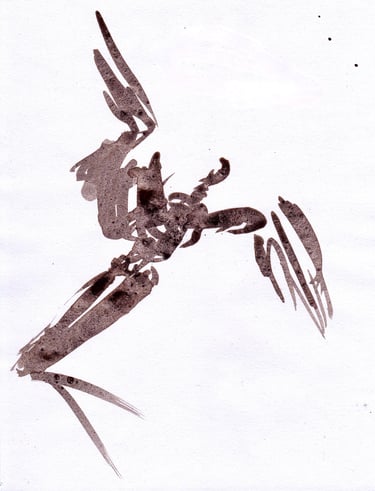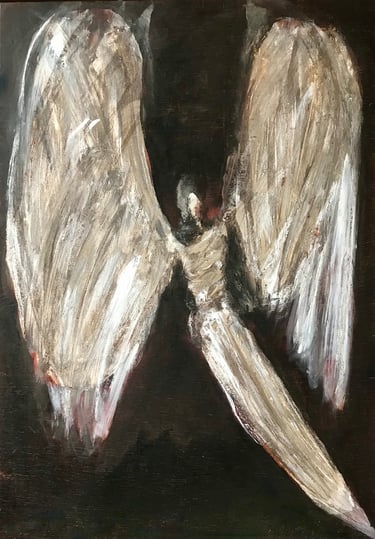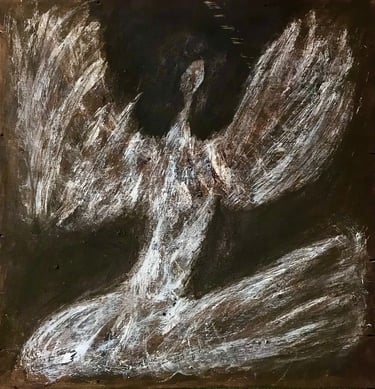





Angel of History
On Blackstone's 55-acres, I found the earthen remains of a long lost inter-cultural site called the ‘Sod Hut’. I contacted the Tasmanian Heritage Register who registered it on their list to ensure its preservation. They sent an archaeologist who declared it to be the oldest known such dwelling in Tasmania, and possibly Australia. The four external walls were worn down by decades of sheep grazing and barely two feet high. In 1829, Governor Arthur had ordered soldiers to build it for George Augustus Robinson, a man who called himself the 'Conciliator', to distribute rations to the Bruny Island Nuenone tribe. Robinson's so-called ‘Friendly Mission’ led to the extinction of nearly all Tasmanian Aboriginals. White settlers, sawyers (timber cutters), and sealers had long subjected the Nuenone to ill-treatment, rape, and murder. In one incident, sawyers offered to row an iconic Neurone woman called Truganini, her Nuenone fiancé and another Nuenone man across the d’Entrecasteaux Channel. In the middle of the Channel, the sawyers pushed the Nuenone men overboard. When they tried to climb back into the boat, the timber cutters chopped off their hands, then raped Truganini.
Blackstone's tragic history became enmeshed with my own grief and sadness and caused my previously naturalistic bird paintings to morph into traumatised angels. It felt inappropriate to use high-key colours so I made pigments from wood ash and native plants. One of the plant resin pigments bled through the paper causing ghost-like images on the reverse. Wood ash was in plentiful supply after I complained to the neighbouring grazier about him shooting wallabies on my land. In response, he started a fire in a fallen tree on our border which quickly spread to my land. I saw the smoke and put out the fire with water from the shore.
Some of the drawings are transcriptions of George Duturreau's 1840 historical painting 'The Conciliation' in the Tasmanian Museum and Art Gallery in Hobart and depicts Robinson meeting the Nuenone.
The title of my 'Angel of History' series is an homage to Walter Benjamin's last essay (below) that he wrote in 1940 before committing suicide in fear of being captured by Nazis and being sent to a concentration camp.
A video of my ANGEL OF HISTORY & CONCILIATION artworks is below.
“A Klee painting named ‘Angelus Novus’ shows an angel looking as though he is about to move away from something he is fixedly contemplating. His eyes are staring, his mouth is open, his wings are spread. This is how one pictures the angel of history. His face is turned toward the past. Where we perceive a chain of events, he sees one single catastrophe which keeps piling wreckage and hurls it in front of his feet. The angel would like to stay, awaken the dead, and make whole what has been smashed. But a storm is blowing in from Paradise; it has got caught in his wings with such a violence that the angel can no longer close them. The storm irresistibly propels him into the future to which his back is turned, while the pile of debris before him grows skyward. This storm is what we call progress.”
PAINTINGS:
Row 1, left to right: Falling Angel, hand-made plant pigments on paper, 18 x 24 cm. Angel of History I, hand-made plant pigments on wood panel, 50 x 50 cm.
Row II: Angel of History II, hand-made plant pigments on wood panel, 90 x 66 cm. Angel of History III, hand-made plant pigments on wood panel, 90 x 66 cm.
© Artwork, video and text copyright Dr. Victoria King 2024.
vkblackstone@gmail.com
© Walter Benjamin quote from On the Concept of History, CreateSpace Independent Publishing Platform, 2011.

My wing is ready for flight, I would like to turn back. If I stayed, Timeless time, I would have little luck.
from On the Concept of History, Essay IX by Walter Benjamin:

